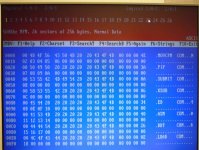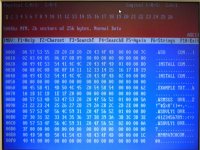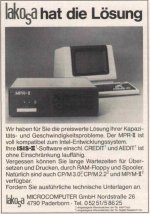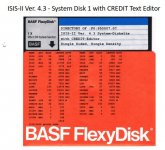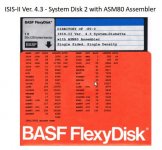; FILE DUMP PROGRAM, READS AN INPUT FILE AND PRINTS IN HEX
;
; COPYRIGHT (C) 1975, 1976, 1977, 1978
; DIGITAL RESEARCH
; BOX 579, PACIFIC GROVE
; CALIFORNIA, 93950
;
ORG 100H
BDOS EQU 0005H ;DOS ENTRY POINT
CONS EQU 1 ;READ CONSOLE
TYPEF EQU 2 ;TYPE FUNCTION
PRINTF EQU 9 ;BUFFER PRINT ENTRY
BRKF EQU 11 ;BREAK KEY FUNCTION (TRUE IF CHAR READY)
OPENF EQU 15 ;FILE OPEN
READF EQU 20 ;READ FUNCTION
;
FCB EQU 5CH ;FILE CONTROL BLOCK ADDRESS
BUFF EQU 80H ;INPUT DISK BUFFER ADDRESS
;
; NON GRAPHIC CHARACTERS
CR EQU 0DH ;CARRIAGE RETURN
LF EQU 0AH ;LINE FEED
;
; FILE CONTROL BLOCK DEFINITIONS
FCBDN EQU FCB+0 ;DISK NAME
FCBFN EQU FCB+1 ;FILE NAME
FCBFT EQU FCB+9 ;DISK FILE TYPE (3 CHARACTERS)
FCBRL EQU FCB+12 ;FILE'S CURRENT REEL NUMBER
FCBRC EQU FCB+15 ;FILE'S RECORD COUNT (0 TO 128)
FCBCR EQU FCB+32 ;CURRENT (NEXT) RECORD NUMBER (0 TO 127)
FCBLN EQU FCB+33 ;FCB LENGTH
;
; SET UP STACK
LXI H,0
DAD SP
; ENTRY STACK POINTER IN HL FROM THE CCP
SHLD OLDSP
; SET SP TO LOCAL STACK AREA (RESTORED AT FINIS)
LXI SP,STKTOP
; READ AND PRINT SUCCESSIVE BUFFERS
CALL SETUP ;SET UP INPUT FILE
CPI 255 ;255 IF FILE NOT PRESENT
JNZ OPENOK ;SKIP IF OPEN IS OK
;
; FILE NOT THERE, GIVE ERROR MESSAGE AND RETURN
LXI D,OPNMSG
CALL ERR
JMP FINIS ;TO RETURN
;
OPENOK: ;OPEN OPERATION OK, SET BUFFER INDEX TO END
MVI A,80H
STA IBP ;SET BUFFER POINTER TO 80H
; HL CONTAINS NEXT ADDRESS TO PRINT
LXI H,0 ;START WITH 0000
;
GLOOP:
PUSH H ;SAVE LINE POSITION
CALL GNB
POP H ;RECALL LINE POSITION
JC FINIS ;CARRY SET BY GNB IF END FILE
MOV B,A
; PRINT HEX VALUES
; CHECK FOR LINE FOLD
MOV A,L
ANI 0FH ;CHECK LOW 4 BITS
JNZ NONUM
; PRINT LINE NUMBER
CALL CRLF
;
; CHECK FOR BREAK KEY
CALL BREAK
; ACCUM LSB = 1 IF CHARACTER READY
RRC ;INTO CARRY
JC FINIS ;DON'T PRINT ANY MORE
;
MOV A,H
CALL PHEX
MOV A,L
CALL PHEX
NONUM:
INX H ;TO NEXT LINE NUMBER
MVI A,' '
CALL PCHAR
MOV A,B
CALL PHEX
JMP GLOOP
;
FINIS:
; END OF DUMP, RETURN TO CCP
; (NOTE THAT A JMP TO 0000H REBOOTS)
CALL CRLF
LHLD OLDSP
SPHL
; STACK POINTER CONTAINS CCP'S STACK LOCATION
RET ;TO THE CCP
;
;
; SUBROUTINES
;
BREAK: ;CHECK BREAK KEY (ACTUALLY ANY KEY WILL DO)
PUSH H! PUSH D! PUSH B; ENVIRONMENT SAVED
MVI C,BRKF
CALL BDOS
POP B! POP D! POP H; ENVIRONMENT RESTORED
RET
;
PCHAR: ;PRINT A CHARACTER
PUSH H! PUSH D! PUSH B; SAVED
MVI C,TYPEF
MOV E,A
CALL BDOS
POP B! POP D! POP H; RESTORED
RET
;
CRLF:
MVI A,CR
CALL PCHAR
MVI A,LF
CALL PCHAR
RET
;
;
PNIB: ;PRINT NIBBLE IN REG A
ANI 0FH ;LOW 4 BITS
CPI 10
JNC P10
; LESS THAN OR EQUAL TO 9
ADI '0'
JMP PRN
;
; GREATER OR EQUAL TO 10
P10: ADI 'A' - 10
PRN: CALL PCHAR
RET
;
PHEX: ;PRINT HEX CHAR IN REG A
PUSH PSW
RRC
RRC
RRC
RRC
CALL PNIB ;PRINT NIBBLE
POP PSW
CALL PNIB
RET
;
ERR: ;PRINT ERROR MESSAGE
; D,E ADDRESSES MESSAGE ENDING WITH "$"
MVI C,PRINTF ;PRINT BUFFER FUNCTION
CALL BDOS
RET
;
;
GNB: ;GET NEXT BYTE
LDA IBP
CPI 80H
JNZ G0
; READ ANOTHER BUFFER
;
;
CALL DISKR
ORA A ;ZERO VALUE IF READ OK
JZ G0 ;FOR ANOTHER BYTE
; END OF DATA, RETURN WITH CARRY SET FOR EOF
STC
RET
;
G0: ;READ THE BYTE AT BUFF+REG A
MOV E,A ;LS BYTE OF BUFFER INDEX
MVI D,0 ;DOUBLE PRECISION INDEX TO DE
INR A ;INDEX=INDEX+1
STA IBP ;BACK TO MEMORY
; POINTER IS INCREMENTED
; SAVE THE CURRENT FILE ADDRESS
LXI H,BUFF
DAD D
; ABSOLUTE CHARACTER ADDRESS IS IN HL
MOV A,M
; BYTE IS IN THE ACCUMULATOR
ORA A ;RESET CARRY BIT
RET
;
SETUP: ;SET UP FILE
; OPEN THE FILE FOR INPUT
XRA A ;ZERO TO ACCUM
STA FCBCR ;CLEAR CURRENT RECORD
;
LXI D,FCB
MVI C,OPENF
CALL BDOS
; 255 IN ACCUM IF OPEN ERROR
RET
;
DISKR: ;READ DISK FILE RECORD
PUSH H! PUSH D! PUSH B
LXI D,FCB
MVI C,READF
CALL BDOS
POP B! POP D! POP H
RET
;
; FIXED MESSAGE AREA
SIGNON: DB 'FILE DUMP VERSION 1.4$'
OPNMSG: DB CR,LF,'NO INPUT FILE PRESENT ON DISK$'
; VARIABLE AREA
IBP: DS 2 ;INPUT BUFFER POINTER
OLDSP: DS 2 ;ENTRY SP VALUE FROM CCP
;
; STACK AREA
DS 64 ;RESERVE 32 LEVEL STACK
STKTOP:
;
END
������

